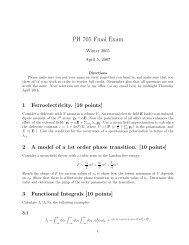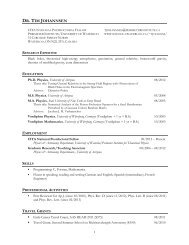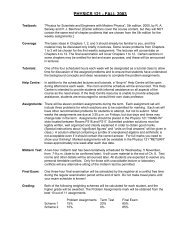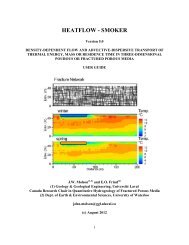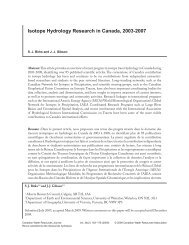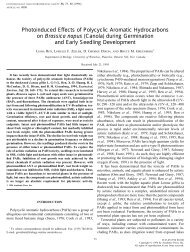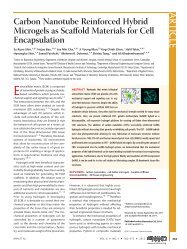J. Mater. Chem., 22, 4759-4766 (2012) - University of Waterloo
J. Mater. Chem., 22, 4759-4766 (2012) - University of Waterloo
J. Mater. Chem., 22, 4759-4766 (2012) - University of Waterloo
You also want an ePaper? Increase the reach of your titles
YUMPU automatically turns print PDFs into web optimized ePapers that Google loves.
View Online<br />
Downloaded by <strong>University</strong> <strong>of</strong> <strong>Waterloo</strong> on 08 March <strong>2012</strong><br />
Published on 30 January <strong>2012</strong> on http://pubs.rsc.org | doi:10.1039/C2JM15273H<br />
Fig. 4<br />
TGA curves <strong>of</strong> LiFePO 4 F, and LiFePO 4 (OH).<br />
the solid materials produced from this reaction were also formed<br />
on thermal decomposition <strong>of</strong> olivine LiFePO 4 under oxidizing<br />
conditions. 29 LiFePO 4 F is more stable in air than FeF 3 , which<br />
was found to hydrolyze at 450 C. 30 LiFePO 4 (OH) decomposes<br />
near 450 C, close to that reported for the decomposition <strong>of</strong><br />
LiFePO 4 (OH) under pure oxygen, 29 and at a significantly lower<br />
temperature than that we observed for LiFePO 4 F. X-ray<br />
diffraction identified both Li 3 Fe 2 (PO 4 ) 3 and Fe 2 O 3 as decomposition<br />
products <strong>of</strong> LiFePO 4 (OH). Clearly, the presence <strong>of</strong><br />
fluoride in the tavorite crystal structure increases the thermal<br />
stability <strong>of</strong> these compounds.<br />
Electrochemical pr<strong>of</strong>iles <strong>of</strong> as-prepared and pulverized<br />
samples <strong>of</strong> LiFePO 4 F cycled at a slow rate (C/50) are shown in<br />
Fig. 5. The initial discharge <strong>of</strong> the as-prepared sample features<br />
a short plateau at 2.75 V followed by a long sloping overcharge<br />
(Fig. 5a). Since the electrode is comprised <strong>of</strong> rather large particles<br />
<strong>of</strong> LiFePO 4 F which are not carbon-coated, the as-prepared<br />
material has a low capacity for Li intercalation (0.55 Li) as well<br />
as high polarization (0.25 V). These shortcomings are eradicated<br />
by pulverizing the as-synthesized material for 3 h in a planetary<br />
ball mill. Although even one hour <strong>of</strong> ball-milling was sufficient,<br />
more than 3 h was counterproductive. An SEM micrograph <strong>of</strong><br />
the active material after milling is shown in the inset <strong>of</strong> Fig. 5b.<br />
The particle morphology has changed significantly from the asprepared<br />
material (see Fig. 1). After milling, the particles have<br />
a spherical shape and range in size from 200–400 nm, and the<br />
carbon is better dispersed. For this material, the electrochemical<br />
pr<strong>of</strong>ile exhibits a sloping curve up to the insertion <strong>of</strong> 0.4 Li into<br />
the structure, at which point the pr<strong>of</strong>ile is flat. This plateau is also<br />
at 2.75 V vs. Li. The cell can reach full capacity (152 mAh/g) and<br />
the polarization <strong>of</strong> this cell is small (0.10 V). As we reported<br />
previously, little capacity fade on cycling was observed for this<br />
material. 9 The electrochemical pr<strong>of</strong>ile <strong>of</strong> the solvothermallyprepared<br />
LiFePO 4 F is shown in Fig. 5c. Although the material<br />
already has a very small particle size, milling with carbon (20–30<br />
min) was necessary to increase the conductivity <strong>of</strong> the electrode.<br />
The pr<strong>of</strong>ile has longer sloping regions but it still has a plateau at<br />
2.75 V for a small portion <strong>of</strong> the cycle. The capacity <strong>of</strong> this<br />
material is slightly lower as only 0.8 Li is intercalated on the first<br />
cycle although this may be due to insufficient dispersion <strong>of</strong> the<br />
conductive carbon black. Although grinding the carbon-free<br />
sample after preparation clearly reduces the primary particle size<br />
Fig. 5 Electrochemical data for LiFePO 4 F vs. Li/Li + collected in coin<br />
cells at a rate <strong>of</strong> C/50 for a) as-synthesized solid-state LiFePO 4 F; b) solidstate<br />
LiFePO 4 F ground in a ball mill for 3 h; solvothermal LiFePO 4 F<br />
ball-milled for 30 min. SEM images <strong>of</strong> prepared electrodes for each<br />
material are shown in the inset.<br />
<strong>of</strong> the electrode material, it is unclear whether the increase in<br />
electrode performance and change in pr<strong>of</strong>ile shape are strictly the<br />
result <strong>of</strong> particle size reduction or whether other factors, such as<br />
the change in particle shape or formation <strong>of</strong> an amorphous iron<br />
fluorophosphate phase, are responsible. However, regardless <strong>of</strong><br />
the method <strong>of</strong> sample preparation, LiFePO 4 F exhibited a flat<br />
voltage plateau at 2.75 V, indicative <strong>of</strong> a two-phase transition.<br />
4762 | J. <strong>Mater</strong>. <strong>Chem</strong>., <strong>2012</strong>, <strong>22</strong>, <strong>4759</strong>–<strong>4766</strong> This journal is ª The Royal Society <strong>of</strong> <strong>Chem</strong>istry <strong>2012</strong>




